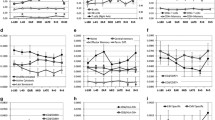Abstract
The system of signaling pattern recognition receptors was studied in eight cosmonauts at the ages from 35 to 56 years before and after long-term space flights (SFs) on board the International Space Station (ISS). The peripheral blood samples were analyzed for the content of monocytes and granulocytes that express the signaling pattern recognition Toll-like receptors (TLRs) with surface (TLR1, TLR2, TLR4, TLR5, and TLR6) and intracellular (TLR3, TLR8, and TLR9) localization. The serum concentration of basic ligands of TLR2 (HSP60) and TLR4 (HSP70 and HMGB1) were also measured. The results of the studies showed a growth of the HSP60, HSP70, and HMGB1 concentrations on the first day after long-term flight. The increase in the concentration of endogenous ligands was followed by a growth of the number of both monocytes and granulocytes that express the respective pattern recognition receptors, TLR2 and TLR4, in the overwhelming majority of the examined cosmonauts. Thesse relationships suggest that changes in the system of signaling pattern recognition receptors may be due to the prevailing influence of endogenous ligands in response to the effect of long-term spaceflight factors on the human body.
Similar content being viewed by others
References
Khaitov, R.M., Pashchenkov, M.V., and Pinegin, B.V., The role of pattern-recognition receptors in innate and adaptive immunity, Immunologiya, 2009, vol. 1, pp. 66–80.
Medzhitov, R. and Janeway, C., Innate immunity, N. Engl. J. Med., 2000, vol. 343, pp. 338–344.
Stowe, R.P., Sams, C.F., Mehta, S.K., et al., Leukocyte subsets and neutrophile function after short-term spaceflight, J. Leukocyte Biol., 1999, vol. 65, p. 179.
Yanssens, S. and Beyard, R., Role of Toll-like receptors in pathogen recognition, Clin. Microbiol. Rev., 2003, vol. 16, pp. 1–19.
Akira, S., Toll-like receptor signaling, J. Biol. Chem., 2003, vol. 278, pp. 38105–38108.
Backhed, F., Normark, S., Schweda, E.K., et al., Structural requirements for TLR4-mediated LPS signaling: a biological role for LPS modifications, Microbes Infect., 2003, no. 5, pp. 1057–1063.
Gargo, A., Tominac, M., Krsulovic-Hresic, V., et al., Increased Toll-like receptors 4 expression in infants with respiratory syncytial virus bronchiolitis, J. Clin. Exp. Immunol., 2004, vol. 135, no. 2, pp. 267.
Medzhitov, R., Toll-like receptors and innate immunity, Nat. Rev. Immunol., 2001, vol. 1, no. 2, pp. 135–145.
Konstantinova, I.V., The immune system in extreme conditions, in Kosmicheskaya immunologiya (Space Immunology), Moscow: Nauka, 1988, pp. 1–289.
Rykova, M.P., Antropova, E.N., and Meshkov, D.O., Results of cosmonauts’ immunological examination during re-adaptation after space flights, in Orbital’naya stantsiya “Mir” (Mir Orbital Station), Moscow: Inst. Med.-Biol. Probl., Ross. Akad. Nauk, 2001, vol. 1, pp. 615–618.
Crucian, B., Stowe, R., and Mehta, S., Immune system dysregulation occurs during short duration spaceflight on board the space shuttle, J. Clin. Immunol., 2013, vol. 33, no. 2, pp. 456–465.
Konstantinova, I.V., Rykova, M.P., Lesnyak, A.T., et al., Immune changes during long-duration missions, J. Leukocyte Biol., 1993, vol. 54, p. 189.
Crucian, B.E., Stowe, R.P., Pierson, D.L., et al., Immune system dysregulation following short-vs longduration spaceflight, Aviat. Space Environ. Med., 2008, vol. 79, p. 835.
Meehan, R.T., Whitson, P., and Sams, C.F., The role of psychoneuroendocrine factors on spaceflightinduced immunological alterations, J. Leukocyte Biol., 1993, vol. 54, p. 236.
Morukov, B., Rykova, M., Antropova, E., et al., T-cell immunity and cytokine production in cosmonauts after long-duration space flights, Acta Astronaut., 2011, vol. 68, pp. 739–746.
Author information
Authors and Affiliations
Corresponding author
Additional information
Original Russian Text © S.A. Ponomarev, T.A. Berendeeva, S.A. Kalinin, A.V. Muranova, 2016, published in Aviakosmicheskaya i Ekologicheskaya Meditsina, 2016, Vol. 50, No. 5, pp. 18–23.
Rights and permissions
About this article
Cite this article
Ponomarev, S.A., Berendeeva, T.A., Kalinin, S.A. et al. The State of the System of Signaling Pattern Recognition Receptors of Monocytes and Granulocytes in the Cosmonauts’ Peripheral Blood before and after Long-Term Flights on Board the International Space Station. Hum Physiol 43, 808–812 (2017). https://doi.org/10.1134/S0362119717070167
Received:
Published:
Issue Date:
DOI: https://doi.org/10.1134/S0362119717070167




